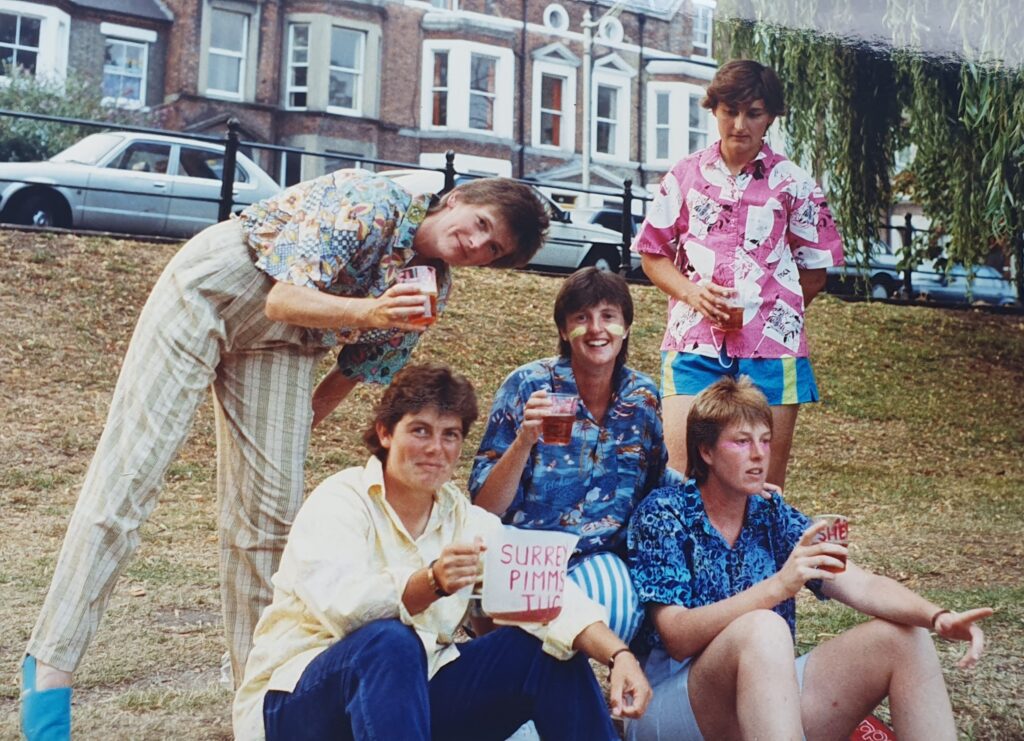“A disaster for the opposition.” “A fierce competitor, but a very fair competitor.” “An amazing cricketing brain.” Just some of the ways in which those who knew Patsy Lovell, Surrey’s most-capped player, will remember her… writes Raf Nicholson.
Patsy – who sadly passed away in April at the age of 69 – represented Surrey between 1974 and 1999. Her career spanned eras: she was 12th player for England v Australia at The Oval in 1976, watching on as Rachael Heyhoe-Flint scored a mammoth 179 to save the Test; two decades later, in 1994, she led Surrey to an 80-run win against an East Anglia side which featured a 14-year-old Charlotte Edwards.
Patsy captained Surrey between 1988 and 1996, and though the statistics are incomplete due to missing scorecards, she took over 177 wickets for the county with her off-spin, and scored over 2000 runs.
The fact that she achieved over 100 caps, at a time when Surrey sometimes played just five or six matches in a season, was a phenomenal achievement which speaks to her determination and, simply, the fact that she loved cricket.
Teammate Caroline Barrs said: “She was very, very proud to represent Surrey. It wasn’t a job, she was never paid – it was a love.”
Patsy also represented England in 10 ODIs, including the 1988 World Cup final in Australia, alongside fellow Surrey legend Jan Brittin. After retiring from cricket, she served as an England selector for 15 years, and helped launch the careers of players including Lydia Greenway and Ebony Rainford-Brent.
“I dread to think what her mileage was,” Greenway said. “She would travel to so many games – she was always there. She wanted to make sure that due diligence was done in terms of seeing the right players.”
Patsy’s highest score for Surrey came against Sussex at the 1990 Area Championship, held in Cambridge that July. She had won the toss and chosen to bat first, entering the fray with Surrey already 69 for 2. A little over two hours later, she was finally dismissed having scored 177 off just 116 balls. Surrey reached 382 for 7 in 55 overs, and went on to bowl Sussex out for 68.
Patsy’s strike rate that day was 153 – simply unheard of at a time when women’s cricket was still decades away from professionalism, and when T20 was not yet invented. Her performance is made all the more incredible by the fact that she did it all while recovering from a serious bout of salmonella poisoning.
“Surrey had played a midweek game at the Lensbury Club,” remembered Barrs. “Half the team got salmonella poisoning, a couple of them got hospitalised, and they had to report it to the Health & Safety Board. That was the Wednesday before the Area Championship started.”
“It was only about three days later. Patsy was still feeling quite poorly, but she decided she had to play anyway – and she somehow scored 177!”
Patricia Ann Lovell MBE was born on 3 May 1954 in Croydon, and was introduced to cricket at an early age by her father. She never had the opportunity to play at school – South Norwood Secondary School offered netball only, much to Patsy’s disappointment – but instead she joined a local club, South Nutfield; later moving to Redoubtables, which was closer to home, and where she would continue to play for the next three decades.
She left school at the age of 16, and went straight to work for insurance firm Legal & General, where she was to spend almost her entire working life. Sport, though, took up all her spare time, and much of her headspace too. England teammate Jane Powell said: “She used to live and breathe cricket, alongside her job. Even when she was working, her heart and her head were thinking cricket.”
Patsy was a talented sportswoman, enjoying netball, squash, badminton and table tennis, representing Lensbury at hockey, and playing football for Crystal Palace. But cricket was her main love, alongside life partner Sue Robinson, who she met when they became teammates for Surrey in the late 1980s.
After two seasons playing for Surrey Juniors, Patsy was selected for the senior team in 1974: she quickly established herself in the side. Left-arm spinner Barrs remembered being nervous to bowl at her during club matches: “We used to play Redoubtables and she aways used to put us into the tennis courts. ‘Oh god, here we go again, into the tennis courts it goes.’ I don’t think the tennis people were very chuffed!”
To Surrey teammate Ann Baker, her off-spin was equally impressive: “She hardly bowled a bad ball.”
Patsy was also extremely popular amongst her teammates – it was they who, in the 1988 pre-season team ballot, voted that she should succeed Baker as Surrey captain. She did the role for nine seasons in total, three times leading them to the final of the Area Championship, a title they came closest to winning in 1988, when they lost by a mere two runs to Yorkshire.
Being captain was not just an on-field job in those days. Patsy spent many hours selecting players, organising umpires and scorers, ringing around with directions to away matches (this was, of course, in the days before sat navs), and finding a week’s worth of bed & breakfast for the entire Surrey team at Cambridge for the duration of the Area Championship.
In 1995, she helped organise the Women’s Cricket Association’s celebration of 250 years of women’s cricket – Surrey vs a WCA Chairman’s XI, hosted at Bramley Cricket Club. The teams received a letter of support from Prime Minister John Major, and the event was recorded by a local television channel.
It’s unclear why it took so long for Patsy to achieve international honours, given her consistent performances for Surrey. She had represented Young England against Australia in 1976, and was part of an England selection weekend ahead of the 1978 World Cup. But, by the time she played her first ODI for England – against Australia at Canterbury in 1987 – she was 33.
When she was selected the following winter for the 1988 World Cup in Australia, she was the oldest of the touring party. Interestingly, despite the fact that she was largely a bowling all-rounder, she was partly chosen as reserve wicketkeeper for that tour, thanks to her excellent hand-eye coordination.
Jane Powell, who captained England in the 1988 World Cup, with Jan Brittin as her deputy, said she relied on Patsy’s experience. “She was a great thinker. She and I would often discuss the intricacies of, ‘do we need that fielder at 45 or should we have them at 42?’ She was one that I could always have those chats with.”
“She understood field placings, how to apply pressure, how to squeeze the opposition. When I watch Charlie Dean play for England now, the way she knows cricket and sets her fields – it reminds me of Patsy.”
Patsy played every match of the tournament, claiming three-wicket hauls against Ireland and the Netherlands, and pouching the winning catch as England shocked everyone by beating hosts Australia in their group-stage match. That sent them into the final, played at the MCG; sadly, Australia got their revenge, winning the final by eight wickets and denying Patsy a winners’ medal.
Barrs, who shared a room with Patsy during the tournament, laughed as she recalled one incident which shines a light on the differences between England women’s cricket, then-and-now: “We’d had a few drinks, and she told me she’d take my tracksuit up – someone had donated them to us for free, but the trousers were far too long for me. I was balanced on this wobbly bed and she just chopped them off at the legs and left me with ankle-swingers. I spent the rest of the tour trying to avoid wearing it!”
Perhaps due to her age, Patsy was never selected for England again, but she continued playing for Surrey and her club, Redoubtables. Her final match for Surrey came in 1999, while her last recorded match was for Redoubtables against Reading-Ridgeway, in August 2003. By then, Patsy’s teammates included Ebony Rainford-Brent, while she was dismissed for five by Ridgeway’s young upstart quick bowler Isa Guha. Another era spanned.
Post-retirement, Patsy continued to serve English cricket via her role on the ECB’s national selection panel. She had initially performed the role for the England U21s (1995 to 1998), but in 1999 she was promoted to a senior selector, serving as Chair of the panel for a season in 2002.
Her views were always influential, due to the sheer amount of time she spent watching cricket. Charlotte Edwards (England captain 2006-16) said: “We’d chat a lot on the boundary edge. I would always seek her advice. She had a great eye for the next players coming through.”
“She spent hours, watching all levels of cricket. You name it, she was probably sat in a chair there somewhere, in the corner of the ground, watching. She just wanted the best players to play for England.”
Selection was a voluntary role, requiring Patsy to work overtime in her day-job to secure the extra time off required. Along with partner Sue Robinson, she also self-funded several trips overseas, because she wanted to see how players, who she had helped to select, performed abroad. She was present in Australia in 2009, when England won the World Cup at North Sydney.
Her tenure as an England selector came to an end in June 2015, when the ECB moved away from the system of having a selection panel and handed control to Head of Performance, who at that time, was Paul Shaw.
The ECB never reinstated the selection panel, but Patsy continued to attend matches, and was often to be found on the boundary edge at Surrey games, sitting in her director’s chair. Her enormous contributions to cricket were recognised in 2006, when she was awarded an MBE for services to sport. In 2022, Surrey presented her with a special gold-embroidered Surrey cap to celebrate her century of caps, while the following year she was awarded honorary life membership of the club – an honour which meant a huge amount to her.
Barrs recalls Sarah Clarke, who was by then captaining the county, approaching Patsy during one match: “She said, ‘I’ve got more wickets than you now, Patsy, so I’m going to retire’. And Patsy just said, ‘All your records are there, but mine aren’t. So when more come to light, I’ll have more than you. Never mind!’”

















